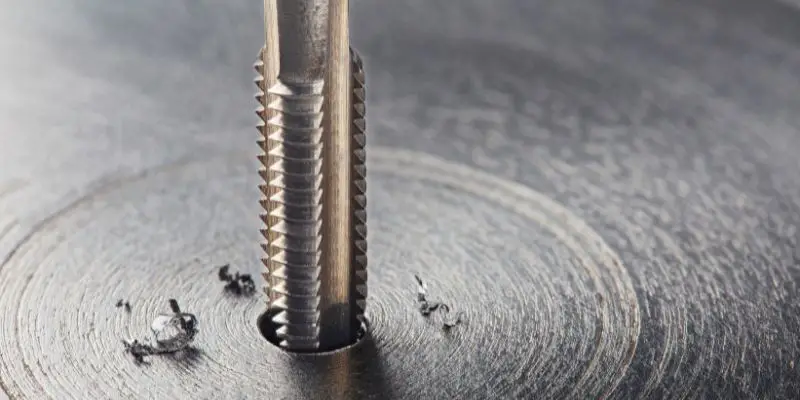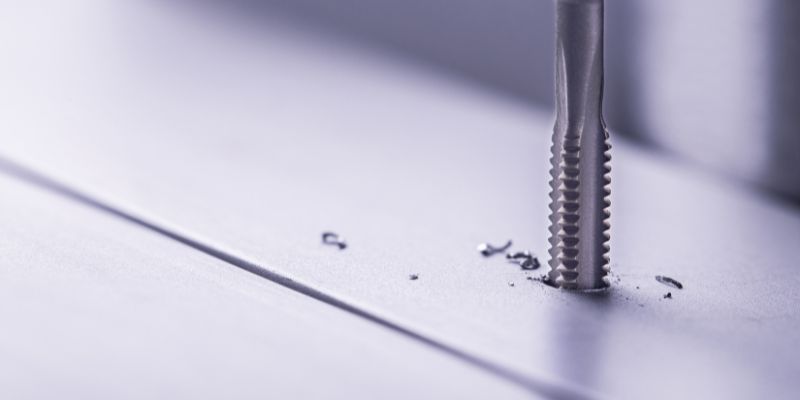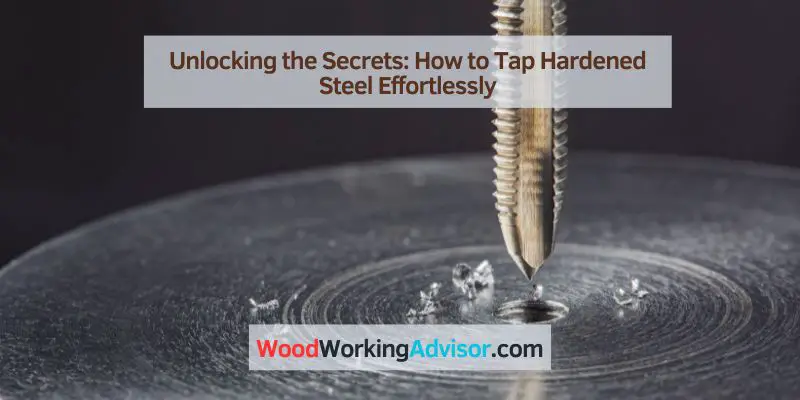To tap hardened steel, use a carbide or cobalt tap and apply steady pressure while turning it clockwise. This will help you create threads in the hardened steel surface efficiently and effectively.
Tapping hardened steel can be a challenging task, but with the right tools and technique, you can achieve it successfully. When dealing with hardened steel, it’s crucial to use a tap that is specifically designed for hard materials like carbide or cobalt taps.
These taps have the necessary hardness to cut through the tough surface of the steel. To tap, apply steady pressure while turning the tap clockwise. This process will gradually cut into the steel and create threads. By following these steps, you can tap hardened steel with ease and precision.
Techniques For Machining Hardened Steel
Machining hardened steel can be a challenging task due to its high level of hardness and resistance. However, with the right techniques, it is possible to tap hardened steel effectively. In this section, we will explore some key techniques that can help achieve successful results when machining hardened steel.
Choosing The Right Tooling And Cutting Parameters
One of the crucial aspects to consider when machining hardened steel is selecting the appropriate tooling. The choice of tooling depends on factors such as the desired thread size, material hardness, and the type of machine being used. Here are some tips to consider:
- Opt for carbide taps: Carbide taps are known for their excellent hardness and wear resistance, making them suitable for tapping hardened steel. They can withstand the high cutting forces involved and maintain their sharpness for longer durations.
- Consider tap coatings: Coatings like TiN (Titanium Nitride) or TiCN (Titanium Carbonitride) can provide enhanced tool life and reduce built-up edge during tapping. These coatings offer increased lubricity, reducing friction and heat generation.
- Adjust cutting parameters: Proper adjustment of cutting parameters such as cutting speed, feed rate, and depth of cut is crucial for tapping hardened steel. Slower cutting speeds and lower feed rates can reduce the risk of tool breakage and promote better chip evacuation.

Utilizing High-speed Machining For Hardened Steel
In recent years, high-speed machining has gained popularity in the machining industry due to its ability to improve productivity and efficiency. When it comes to machining hardened steel, high-speed machining techniques can be beneficial. Here’s how:
- Use high-speed steel (HSS) taps: High-speed steel taps are designed to withstand higher cutting speeds and temperatures, making them suitable for high-speed machining of hardened steel. They can provide excellent heat resistance and maintain their cutting edges for extended periods.
- Optimize machine parameters: High-speed machining requires proper optimization of machine parameters such as spindle speed, feed rate, and cutting depth. Faster cutting speeds with smaller, controlled depths of cut can improve material removal rates and reduce tool wear.
- Implement coolant or lubricant strategies: Proper cooling and lubrication play a vital role in high-speed machining of hardened steel. Using coolants or lubricants can prevent tool overheating, minimize friction, and improve chip evacuation, resulting in enhanced machining performance.
Heat Treatment And Surface Coatings
Heat treatment and surface coatings are additional techniques that can improve the machinability of hardened steel. Here’s how they can be utilized:
- Pre- and post-machining heat treatment: Heat treatment processes like annealing or stress relief can be performed before machining to reduce hardness and make the material more malleable. Post-machining heat treatment, such as tempering, can restore the hardness and enhance the overall mechanical properties.
- Surface coatings: Applying surface coatings on hardened steel can provide additional benefits such as improved wear resistance and reduced friction during tapping. Coatings like PVD (Physical Vapor Deposition) or DLC (Diamond-Like Carbon) can improve tool life and performance.
Advanced Strategies For Working With Hardened Steel
When it comes to working with hardened steel, it requires advanced strategies to achieve the desired results. In this section, we will explore three effective methods for working with hardened steel: Electrical Discharge Machining (EDM), Laser Machining, and Ultrasonic Machining. These techniques offer precision, speed, and versatility, making them invaluable in various industries. Let’s delve into each method and understand how they can be used to tap hardened steel.
Electrical Discharge Machining (edm)
One of the most preferred and widely used methods for tapping hardened steel is Electrical Discharge Machining (EDM). This technique involves the use of electrical discharges to erode material from the workpiece. EDM offers several advantages, such as high precision, exceptional surface finish, and the ability to work with complex geometries. It uses a controlled electrical spark to remove material and create threaded holes in hardened steel.
Here are some key features of Electrical Discharge Machining:
- Precision: EDM can achieve extremely precise dimensions, making it suitable for tapping hardened steel with tight tolerances.
- Surface Finish: The process leaves a smooth surface finish, minimizing the need for additional post-processing.
- Complex Geometries: EDM can work with intricate designs and shapes, allowing you to tap hardened steel in various configurations.
- Heat Resistance: As EDM doesn’t involve direct contact between the tool and the workpiece, it eliminates the risk of heat-induced damage.
Laser Machining
Laser Machining is another advanced strategy for tapping hardened steel. It utilizes a high-energy laser beam to remove material from the workpiece and create threaded holes. Laser Machining offers exceptional precision and speed, making it a popular choice for industries that require high-volume production and intricate designs.
Here’s why Laser Machining is an excellent technique:
- Precision: Laser technology ensures accurate hole positioning and dimension control, resulting in precise tapped holes in hardened steel.
- Speed: The high-energy laser beam allows for rapid material removal, reducing production time and increasing efficiency.
- No Tooling Wear: Unlike conventional tapping methods, Laser Machining eliminates the need for physical tools, minimizing tool wear and reducing maintenance costs.
- Automation: Laser Machining can be easily integrated into automated systems, enabling continuous and uninterrupted production.

Ultrasonic Machining
Ultrasonic Machining is a unique method that utilizes ultrasonic vibrations along with abrasive slurry to tap hardened steel. This technique is especially useful for materials that are difficult to machine using conventional methods. Ultrasonic Machining offers superb accuracy and is effective in creating precise threaded holes in hardened steel.
Here are the benefits of Ultrasonic Machining:
- Accurate Results: Ultrasonic vibrations combined with abrasives produce highly precise and smooth tapped holes in hardened steel.
- Reduced Force: The vibrations of the tool decrease the force required, minimizing the risk of damage to the workpiece.
- Non-thermal Process: Ultrasonic Machining doesn’t generate excessive heat, ensuring the integrity of the hardened steel.
- Wide Range of Applications: This method is suitable for machining various materials, including hardened steel with different hardness levels.
Frequently Asked Questions Of How To Tap Hardened Steel
Is It Possible To Tap Hardened Steel?
Yes, it is possible to tap hardened steel. Tapping is a process of creating threads in materials, and while hardened steel is more challenging to tap, it can still be done with the right tools and techniques.
How Do You Tap Hard Metal?
To tap hard metal, follow these steps:
1. Choose the appropriate tap size.
2. Use a center punch to create a pilot hole.
3. Place the tap into the hole and turn it slowly, applying consistent pressure.
4. Use cutting fluid to lubricate the process.
5. Remove the tap carefully to avoid damage.
How Do You Soften Hardened Steel?
To soften hardened steel, heat it to a specific temperature, known as the critical temperature, and then gradually cool it down. This process is called annealing and helps to reduce the hardness and improve the metal’s machinability.
How Do You Get Through Hardened Steel?
To get through hardened steel, you can use a diamond-tipped drill or a special metal-cutting tool. These tools are designed to withstand the hardness of the steel and effectively cut through it.
Conclusion
Tapping hardened steel requires a combination of the right tools, techniques, and patience. By choosing the appropriate drill bits, lubricants, and tapping methods, you can ensure a successful outcome. Remember to take your time and apply steady pressure to avoid damaging the steel.
With practice and careful attention to detail, you’ll be able to thread hardened steel with ease. Keep these tips in mind and enjoy the challenge of working with this durable material.


